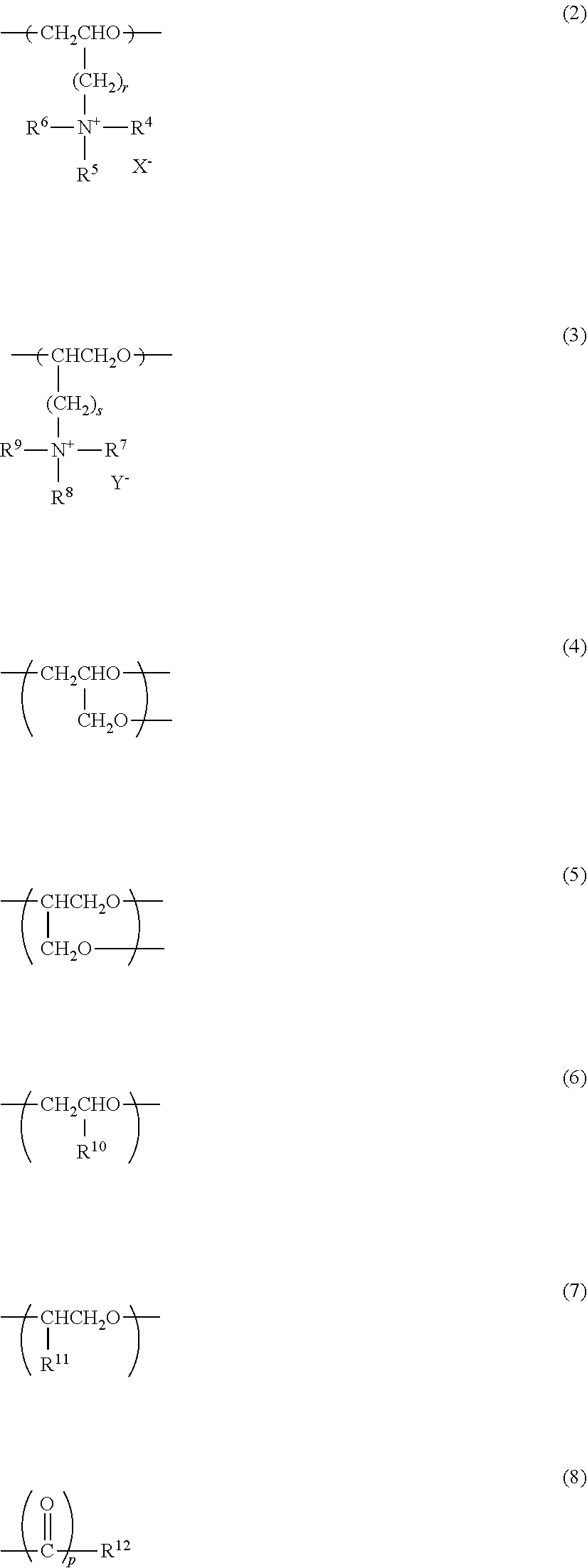Cellulose ether containing cationic group
a technology of cellulose ether and cellulose ether, which is applied in the field of cationic groupcontaining cellulose ether, can solve the problems of hair generating a feeling of squeakiness and entanglemen
- Summary
- Abstract
- Description
- Claims
- Application Information
AI Technical Summary
Benefits of technology
Problems solved by technology
Method used
Image
Examples
examples
[0381]In the following Production Examples, Examples and Comparative Examples, “%” means “% by mass”. The group represented by the above-mentioned general formula (6) and the group represented by the above-mentioned general formula (7), where R10 and R11 are methyl groups, respectively, are collectively referred to as “oxypropylene group” in the following Examples, the groups where R10 and R11 are ethyl groups in the above-mentioned formulae (6) and (7) are collectively referred to as “oxybutylene group” and the groups where R10 and R11 are butyl groups in the above-mentioned formulae (6) and (7) are collectively referred to as “oxyhexylene group”. Physical properties and others were measured according to the methods mentioned below.
(1) Measurement of Viscosity-Average Degree of Polymerization of Cellulose (cuprammonium process)
(1-1) Viscosity-Average Degree of Polymerization of Cellulose and CCE
(i) Preparation of Solution for Measurement
[0382]0.5 g of cuprous chloride, and 20 to 30...
production example a
Production of Starting Internal Olefin A
[0428]7000 g (28.9 mol) of 1-hexadecanol (Kalcol 6098, by Kao) and 700 g (10% by mass relative to the starting alcohol) of γ-alumina (by STREM Chemicals, Inc.) serving as a solid acid catalyst were put into a flask equipped with a stirrer, and while nitrogen (7000 mL / min) was circulated inside the system at 280° C. with stirring, this was reacted for 3 hours. After the reaction, the alcohol conversion was 100%, and the C16 internal olefin purity was 99.6%. The obtained, crude internal olefin was transferred into a distillation flask and distilled therein at 136 to 160° C. / 4.0 mmHg to give an internal olefin having a carbon number of 16 and having an olefin purity of 100%. The double bond distribution of the thus-obtained internal olefin was: 1.8% by mass at C1, 30.4% by mass at C2, 23.9% by mass at C3, 16.8% by mass at C4, 12.0% by mass at C5, 7.4% by mass at C6, and 7.8% by mass at C7 and C8 in total.
production example b
Production of Starting Internal Olefin B
[0429]7000 g (25.9 mol) of 1-octadecanol (Kalcol 8098, by Kao) and 700 g (10% by mass relative to the starting alcohol) of γ-alumina (by STREM Chemicals, Inc.) serving as a solid acid catalyst were put into a flask equipped with a stirrer, and while nitrogen (7000 mL / min) was circulated inside the system at 280° C. with stirring, this was reacted for 10 hours. After the reaction, the alcohol conversion was 100%, and the C18 internal olefin purity was 98.2%. The obtained, crude internal olefin was transferred into a distillation flask and distilled therein at an internal temperature of 148 to 158° C. / 0.5 mmHg to give an internal olefin having a carbon number of 18 and having an olefin purity of 100%. The double bond distribution of the thus-obtained internal olefin was: 0.8% by mass at C1, 31.3% by mass at C2, 22.9% by mass at C3, 15.5% by mass at C4, 10.8% by mass at C5, 7.2% by mass at C6, 5.3% by mass at C7, and 6.2% by mass at C8 and C9 in ...
PUM
| Property | Measurement | Unit |
|---|---|---|
| Percent by mass | aaaaa | aaaaa |
| Percent by mass | aaaaa | aaaaa |
| Percent by mass | aaaaa | aaaaa |
Abstract
Description
Claims
Application Information
 Login to View More
Login to View More - R&D
- Intellectual Property
- Life Sciences
- Materials
- Tech Scout
- Unparalleled Data Quality
- Higher Quality Content
- 60% Fewer Hallucinations
Browse by: Latest US Patents, China's latest patents, Technical Efficacy Thesaurus, Application Domain, Technology Topic, Popular Technical Reports.
© 2025 PatSnap. All rights reserved.Legal|Privacy policy|Modern Slavery Act Transparency Statement|Sitemap|About US| Contact US: help@patsnap.com



